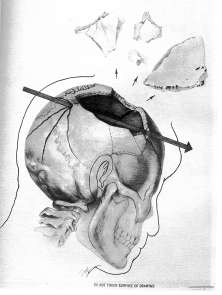
Conspiracy theorists have long and loudly insisted that any medical witness who described John Kennedy's head wound as "occipital," must be describing the back of his head blown out, and this — supposedly — proves a Grassy Knoll shooter.
But in fact, the House Select Committee on Assassinations consistently described as "occipital" the entrance wound in the back of Kennedy's head, a wound they explicitly placed in the "cowlick area" and explicitly said was four inches above the external occipital protuberance. A medical drawing by Ida Dox, commissioned by the House Select Committee (above, right) shows this location.
The following are some quotes, all from the House Select Committee on Assassinations, volume 7:
(298) Examination of the enhanced photographs* prepared from the by 5 inch color transparency of the photograph of the back of the head (print No. 4g) reveals more sharply contrasted detail of the wound described in the upper occipital region [emphasis added] and the dried brain tissue in the lower occipital region. Stereoscopic visualization of this fragment indicates that it is adherent to and on the surface of the hair. Computer-assisted image enhancement of this photograph reveals a dark oval shadow within the margins of the scalp perforation in the cowlick area which may be the perforation of the underlying skull. The hole in the scalp lines up with the hole in the skull. The X-rays also locate the skull defect at this point.Conspiracy books assume that "occipital" must mean the area of the occipital bone. Thus an "occipital" wound must imply missing occipital bone. Yet the House Select Committee Forensic Pathology Panel clearly isn't using the word in this way.[...]
FIGURE 17.—Photograph of the anterior-posterior X-ray of the skull (autopsy X-ray No. 1), showing the occipital defect [emphasis added] and adjacent missile fragment.
[...]
FIGURE 18.—Photograph of the lateral X-ray of the skull (autopsy X-ray No.2), showing the occipital defect [emphasis added] with beveling and adjacent missile fragment.
[...]
(303) Computer-assisted image enhancement of this film more sharply delineates the fracture lines and bone fragments, as well as the missile fragment in the occipital region [emphasis added]. The defect in the skull and the inward beveling* thereof provide definite evidence of an entrance wound of the head at a point corresponding to that noted by the panel in the upper back of the scalp, rather than "slightly above" the external occipital protuberance as indicated in the autopsy report . . .
Likewise, in the late 1960s, four eminent forensic pathologists examined the autopsy materials at the request of Attorney General Ramsey Clark. They concluded:
The foregoing observations indicate that the decedent's head was struck from behind a single projectile. It entered the occipital region 25 mm to the right of the midline and 100 mm. above the external occipital protuberance. The projectile fragmented on entering the skull, one major section leaving a trail of fine metallic debris as it passed forward and laterally to explosively fracture the right frontal and parietal bones as it emerged from the head.Yet 100 mm. (about four inches) above the external occipital protuberance is in fact parietal bone. This is the exact point of entrance in the drawing done by Ida Dox for the House Select Committee (see above, right). Yet it is in the "occipital region." The Boston Globe, in an article addressing this issue, noted the following:
To critics of the official investigations, it is inconceivable that the presumably skilled Dallas doctors, conversant with anatomical terms, would consistently misuse words like "cerebellum" and "occipital" and say that the wound extended into the back of the head if, in fact, it did not.Grossman's position is supported by the "Glossary" of medical definitions offered by the House Select Committee on Assassinations:But speaking to the occipital question, Grossman [one of the Parkland doctors and] a neurosurgeon, suggested that part of the confusion surrounding the location of the head wound could be the result of the imprecision with which the term "occipital" is used. While the occiput refers specifically to a bone in the lower back section of the head, Grossman said many doctors loosely use the term to refer to "the back fifth of the head . . . there is this ambiguity about what constitutes the occipital and parietal area . . . It's all very imprecise." (Boston Sunday Globe, June 21, 1981.)
Of course, the issue is much like that of witnesses who said the large defect was in the "back" of the head. "Back" can mean occipital bone, or it can mean the top of the head toward the back. Back can mean "posterior," in other words.
What the conspiracy theorists are doing is to exploit the imprecision of the English language to argue for wounds that fit their theories.